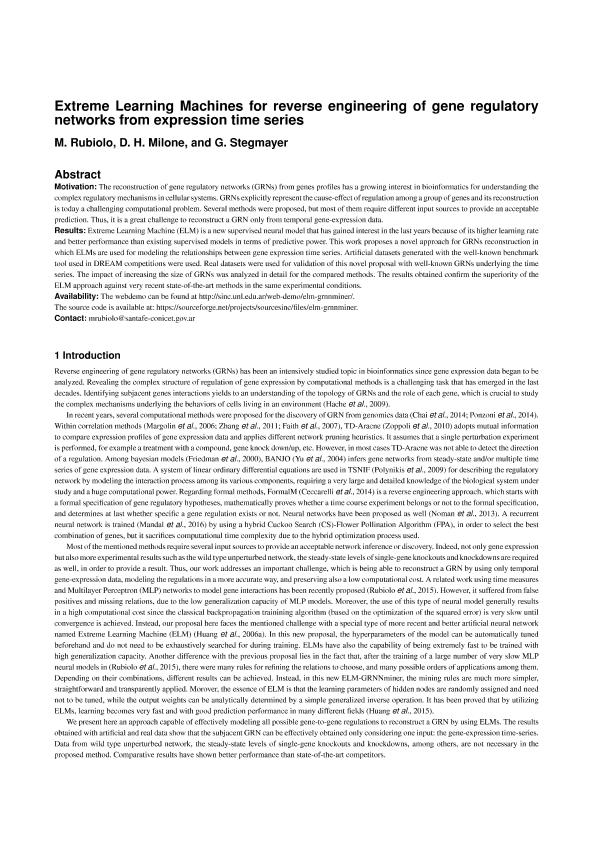Mostrar el registro sencillo del ítem
dc.contributor.author
Rubiolo, Mariano

dc.contributor.author
Milone, Diego Humberto

dc.contributor.author
Stegmayer, Georgina

dc.date.available
2018-06-01T20:51:17Z
dc.date.issued
2017-11
dc.identifier.citation
Rubiolo, Mariano; Milone, Diego Humberto; Stegmayer, Georgina; Extreme learning machines for reverse engineering of gene regulatory networks from expression time series; Oxford University Press; Bioinformatics (Oxford, England); 34; 7; 11-2017; 1253-1260
dc.identifier.issn
1367-4803
dc.identifier.uri
http://hdl.handle.net/11336/47065
dc.description.abstract
The reconstruction of gene regulatory networks (GRNs) from genes profiles has a growing interest in bioinformatics for understanding the complex regulatory mechanisms in cellular systems. GRNs explicitly represent the cause-effect of regulation among a group of genes and its reconstruction is today a challenging computational problem. Several methods were proposed, but most of them require different input sources to provide an acceptable prediction. Thus, it is a great challenge to reconstruct a GRN only from temporal gene-expression data. Results: Extreme Learning Machine (ELM) is a new supervised neural model that has gained interest in the last years because of its higher learning rate and better performance than existing supervised models in terms of predictive power. This work proposes a novel approach for GRNs reconstruction in which ELMs are used for modeling the relationships between gene expression time series. Artificial datasets generated with the well-known benchmark tool used in DREAM competitions were used. Real datasets were used for validation of this novel proposal with well-known GRNs underlying the time series. The impact of increasing the size of GRNs was analyzed in detail for the compared methods. The results obtained confirm the superiority of the ELM approach against very recent state-of-the-art methods in the same experimental conditions.<br />
dc.format
application/pdf
dc.language.iso
eng
dc.publisher
Oxford University Press

dc.rights
info:eu-repo/semantics/openAccess
dc.rights.uri
https://creativecommons.org/licenses/by-nc-sa/2.5/ar/
dc.subject
Extreme Learning Machine
dc.subject
Gene Regulatory Networks
dc.subject
Gene Expression
dc.subject
Prediction
dc.subject.classification
Ciencias de la Computación

dc.subject.classification
Ciencias de la Computación e Información

dc.subject.classification
CIENCIAS NATURALES Y EXACTAS

dc.title
Extreme learning machines for reverse engineering of gene regulatory networks from expression time series
dc.type
info:eu-repo/semantics/article
dc.type
info:ar-repo/semantics/artículo
dc.type
info:eu-repo/semantics/publishedVersion
dc.date.updated
2018-05-31T18:19:09Z
dc.journal.volume
34
dc.journal.number
7
dc.journal.pagination
1253-1260
dc.journal.pais
Reino Unido

dc.journal.ciudad
Oxford
dc.description.fil
Fil: Rubiolo, Mariano. Consejo Nacional de Investigaciones Científicas y Técnicas. Centro Científico Tecnológico Conicet - Santa Fe. Instituto de Investigación en Señales, Sistemas e Inteligencia Computacional. Universidad Nacional del Litoral. Facultad de Ingeniería y Ciencias Hídricas. Instituto de Investigación en Señales, Sistemas e Inteligencia Computacional; Argentina
dc.description.fil
Fil: Milone, Diego Humberto. Consejo Nacional de Investigaciones Científicas y Técnicas. Centro Científico Tecnológico Conicet - Santa Fe. Instituto de Investigación en Señales, Sistemas e Inteligencia Computacional. Universidad Nacional del Litoral. Facultad de Ingeniería y Ciencias Hídricas. Instituto de Investigación en Señales, Sistemas e Inteligencia Computacional; Argentina
dc.description.fil
Fil: Stegmayer, Georgina. Consejo Nacional de Investigaciones Científicas y Técnicas. Centro Científico Tecnológico Conicet - Santa Fe. Instituto de Investigación en Señales, Sistemas e Inteligencia Computacional. Universidad Nacional del Litoral. Facultad de Ingeniería y Ciencias Hídricas. Instituto de Investigación en Señales, Sistemas e Inteligencia Computacional; Argentina
dc.journal.title
Bioinformatics (Oxford, England)

dc.relation.alternativeid
info:eu-repo/semantics/altIdentifier/url/http://academic.oup.com/bioinformatics/advance-article/doi/10.1093/bioinformatics/btx730/4648509
dc.relation.alternativeid
info:eu-repo/semantics/altIdentifier/doi/http://dx.doi.org/10.1093/bioinformatics/btx730
Archivos asociados
